Free Online Productivity Tools
i2Speak
i2Symbol
i2OCR
iTex2Img
iWeb2Print
iWeb2Shot
i2Type
iPdf2Split
iPdf2Merge
i2Bopomofo
i2Arabic
i2Style
i2Image
i2PDF
iLatex2Rtf
Sci2ools
MMS
2006
2006
View-invariant motion trajectory-based activity classification and recognition
Motion trajectories provide rich spatio-temporal information about an object's activity. The trajectory information can be obtained using a tracking algorithm on data streams available from a range of devices including motion sensors, video cameras, haptic devices, etc. Developing view-invariant activity recognition algorithms based on this high dimensional cue is an extremely challenging task. This paper presents efficient activity recognition algorithms using novel view-invariant representation of trajectories. Towards this end, we derive two Affine-invariant representations for motion trajectories based on curvature scale space (CSS) and centroid distance function (CDF). The properties of these schemes facilitate the design of efficient recognition algorithms based on hidden Markov models (HMMs). In the CSS-based representation, maxima of curvature zero crossings at increasing levels of smoothness are extracted to mark the location and extent of concavities in the curvature. Th...
| Added | 14 Dec 2010 |
| Updated | 14 Dec 2010 |
| Type | Journal |
| Year | 2006 |
| Where | MMS |
| Authors | Faisal I. Bashir, Ashfaq A. Khokhar, Dan Schonfeld |
Comments (0)

